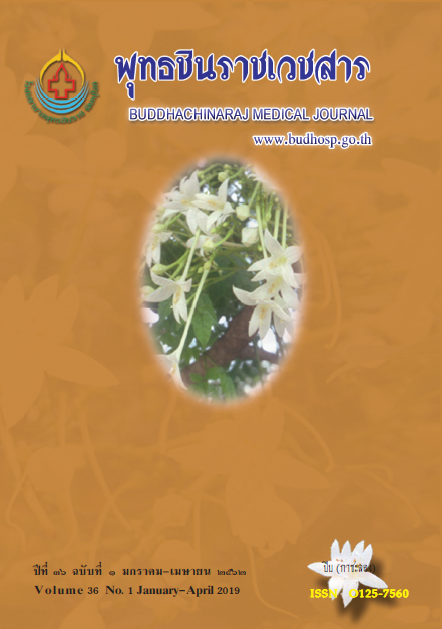ปัจจัยทำนายวัฒนธรรมความปลอดภัยของผู้ป่วยในมุมมองผู้ให้บริการ ในโรงพยาบาลชุมชนจังหวัดพิษณุโลก
คำสำคัญ:
วัฒนธรรมความปลอดภัยของผู้ป่วย, ผู้ให้บริการ, โรงพยาบาลชุมชนบทคัดย่อ
ปัจจุบันความปลอดภัยของผู้ป่วยและคุณภาพการบริการทางการแพทย์ได้รับความสนใจเพิ่มสูงขึ้น การศึกษา เกี่ยวกับความปลอดภัยของผู้ป่วยส่งผลให้คุณภาพด้านความปลอดภัยของผู้ป่วยเกิดการพัฒนา วิจัยครั้งนี้เป็นการ วิจัยเชิงทำนายเพื่อศึกษาปัจจัยทำนายวัฒนธรรมความปลอดภัยของผู้ป่วยในมุมมองผู้ให้บริการในโรงพยาบาลชุมชน ในจังหวัดพิษณุโลกกลุ่มตัวอย่างคือบุคลากรที่ปฏิบัติงานในโรงพยาบาลชุมชนในจังหวัดพิษณุโลกจำนวน 176 คน ได้มาจากการสุ่มตัวอย่างแบบแบ่งชั้นภูมิเก็บรวบรวมข้อมูลโดยให้บุคลากรที่ปฏิบัติงานตอบแบบสอบถามวิเคราะห์ ข้อมูลโดยใช้ความถี่ ร้อยละ ค่าเฉลี่ย ส่วนเบี่ยงเบนมาตรฐาน และวิเคราะห์หาปัจจัยทำนายวัฒนธรรมความปลอดภัย ของผู้ป่วยในมุมมองผู้ให้บริการด้วยการวิเคราะห์ถดถอยพหุคูณแบบขั้นตอนผลการศึกษาพบว่าวัฒนธรรม ความปลอดภัยของผู้ป่วยในโรงพยาบาลชุมชนที่ศึกษาอยู่ในระดับสูง ( = 3.70, SD = 0.384) ปัจจัยทำนาย วัฒนธรรมความปลอดภัยของผู้ป่วยในมุมมองผู้ให้บริการได้แก่ปัจจัยผู้บริหาร (Beta = 0.337) ปัจจัยทีมงาน (Beta = 0.255) ปัจจัยความรับผิดชอบของบุคลากรด้านความปลอดภัยของผู้ป่วย (Beta = 0.240) ปัจจัยสภาพ แวดล้อมในการทำงาน (Beta = 0.224) และการฝึกอบรมเกี่ยวกับการพัฒนาคุณภาพด้านความปลอดภัยของ ผู้ป่วย (Beta = 0.089) โดยสามารถทำนายวัฒนธรรมความปลอดภัยของผู้ป่วยในมุมมองผู้ให้บริการได้ร้อยละ 71 ผลการศึกษาพบว่าบุคลากรมีความรับผิดชอบด้านความปลอดภัยของผู้ป่วยในระดับสูง การกระตุ้นและส่งเสริม วัฒนธรรมความปลอดภัยของผู้ป่วยที่ระดับบุคคลให้มีการปฏิบัติที่ผสานระหว่างคุณภาพกับความปลอดภัยของ ผู้ป่วยในงานอย่างต่อเนื่องอาจส่งผลให้เป็นองค์กรที่น่าไว้วางใจต่อไป
เอกสารอ้างอิง
2. Sammer CE, Lykens K, Singh KP, Mains DA, Lackan NA. What is patient safety culture? A review of the literature. J Nurs Scholarsh 2010;42(2):156-65.
3. Supachutikul A. HA Update 2013.Nonthaburi:The Healthcare Accreditation Institute (Public Organization);2013.
4. Ulrich B, Kear T. Patient safety and patient safety culture:Foundations of excellent health care delivery. Nephrol Nurs J 2014;41(5):447-505.
5. Kaaslangkaa A. Study of medical problems and healthcare provider of ministry of public health and office of permanent secretary sued because of medical treatment. J Depart Health Serv Supp 2013;9(1):57-69.
6. National Health Security Office. Annual report 2016. Bangkok: Abizintergroup;2017.
7. National Health Security Office. Annualreport 2013. Bangkok: Sahamitr printingand publish;2014.
8. Kessomboon P, Kessomboon N, Pannarunothai S, Premgamone A. Claimants of Compensation for Adverse Clinical Events Occurring in Hospitals. J Health SysRes 2009;3(4):567-72.
9. Wangthong Hospital.Hospital Profile. Phitsanulok:Focus printing;2014.
10. Xuanyue M, Yanli N, Hao C, Pengli J, Mingming Z. Literature review regarding patient safety culture. J Evid Base Med 2013;6:43-9.
11. Vincent C,Sally TA,Nicola S. Framework for analysing risk and safety in clinical medicine [Internet]. 1998[cited 2016 Mar 17]. Available from: https://www.ncbi.nlm.nih. gov/pmc/articles/PMC 1112945/.
12. Kilakuldilok P, Phonpasurt W, Keyuranon P. Safety Culture of Registered Nurses Who Work on Offices of Public Health in PathumThani Province [Internet]. 2011[cited 2019 May 26]. Available from https://www.stou.ac.th/thai/grad_stdy/Masters/.../ FullPaper/Sci/Poster/P-Sci81.pdf.
13. Abdolahzadeh F, Zamanzadeh V, Boroumand A. Studying the relationship between individual and organizational factors and nurses' perception of patient safety culture [Internet]. 2012[cited 2019 May 26].Available from http:// journals.tbzmed.ac.ir/JCS.
14. Kim IS, Park M, Park MY, Yoo H, Choi J. Factors Affecting the Perception of Importance and Practice of Patient Safety Management among Hospital Employees in Korea. Asian Nurs Res (Korean Soc Nurs Sci) 2013;7(1):26-32.
15. Faul F, Erdfelder E, Buchner A, Lang AG. Statistical power analyses usingG*Power 3.1: tests for correlation and regression analyses. Behav Res Methods2009; 41(4):1149-60.
16. Cohen J. Quantitative Methods in Psychology: A Power Primer.Psychol Bull 1992;112:155-9.
17. Suphachutikun A. Patient Safety Goals:SIMPLE. Bangkok:The healthcare accreditation institute (public organization);2008.
18. Best JW. Research in Education. 3rd ed. New Jersey:Prentice Hall;1997.
19. Thatreenaranon S, Keyuranon P, Prasertchai A. Factors affecting patient safety culture in Somdet Chaopraya institute of psychiatry. J Psychiatr Ment Health Nurs 2013;27(2):43-55.
20. Phookaengmoke P. 4As to safety culture. [Internet]. 2018[cited 2019 May 25]. Available fromhttp://www.pinthong-group.com/content/content_detail.php? id=395.
21. Prapunwattana M. Safety medication system. Bangkok: The association of Hospital Pharmacy (Thailand );2014.
22. Sngounsiritham U. Management for Creating Safety Culture in Nursing Service. Nurs J 2011;38(3):168-77.
23. Wangthong Hospital.Self Assesment Part II-1.Phitsanulok:Focus printing;2013.
24. Jirapaet V, Jirapaet K. Patient safety management: concepts, processes and guidelines for clinical safety. Bangkok:Dansutha Publisher;2012.
25. Chuaytawee J, Songthai N. Factors Influencing Nurses' Perceptions on Patient Safety Culture in The Community Hospitals, Phitsanulok Province. J Nurs Health Sci 2018;11(3):42-51.






